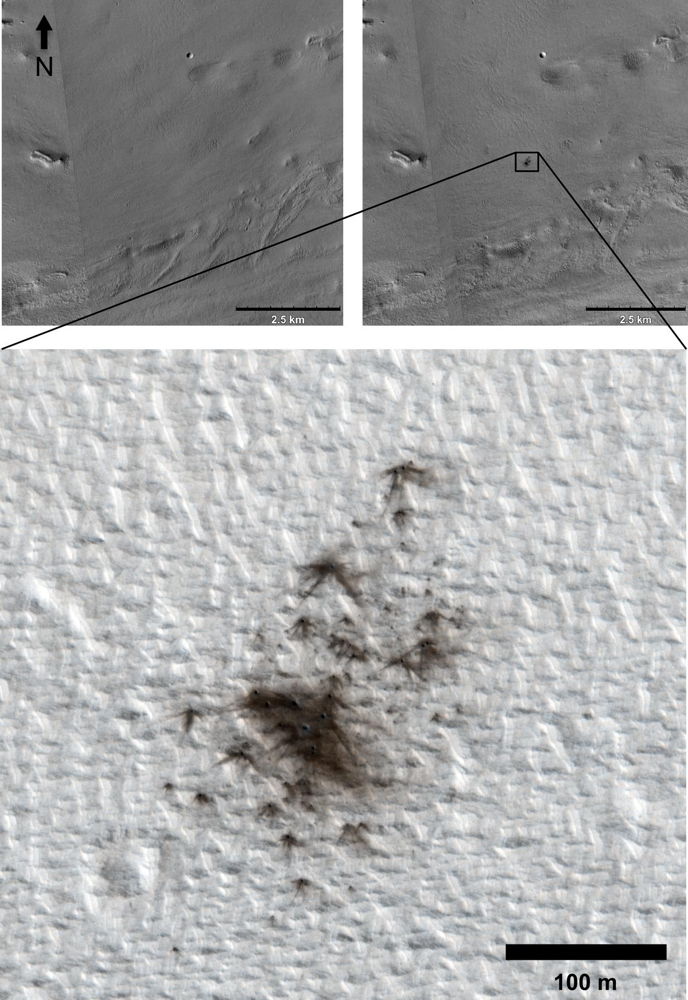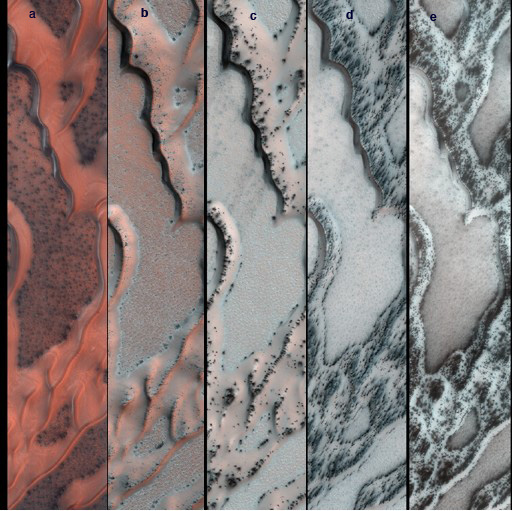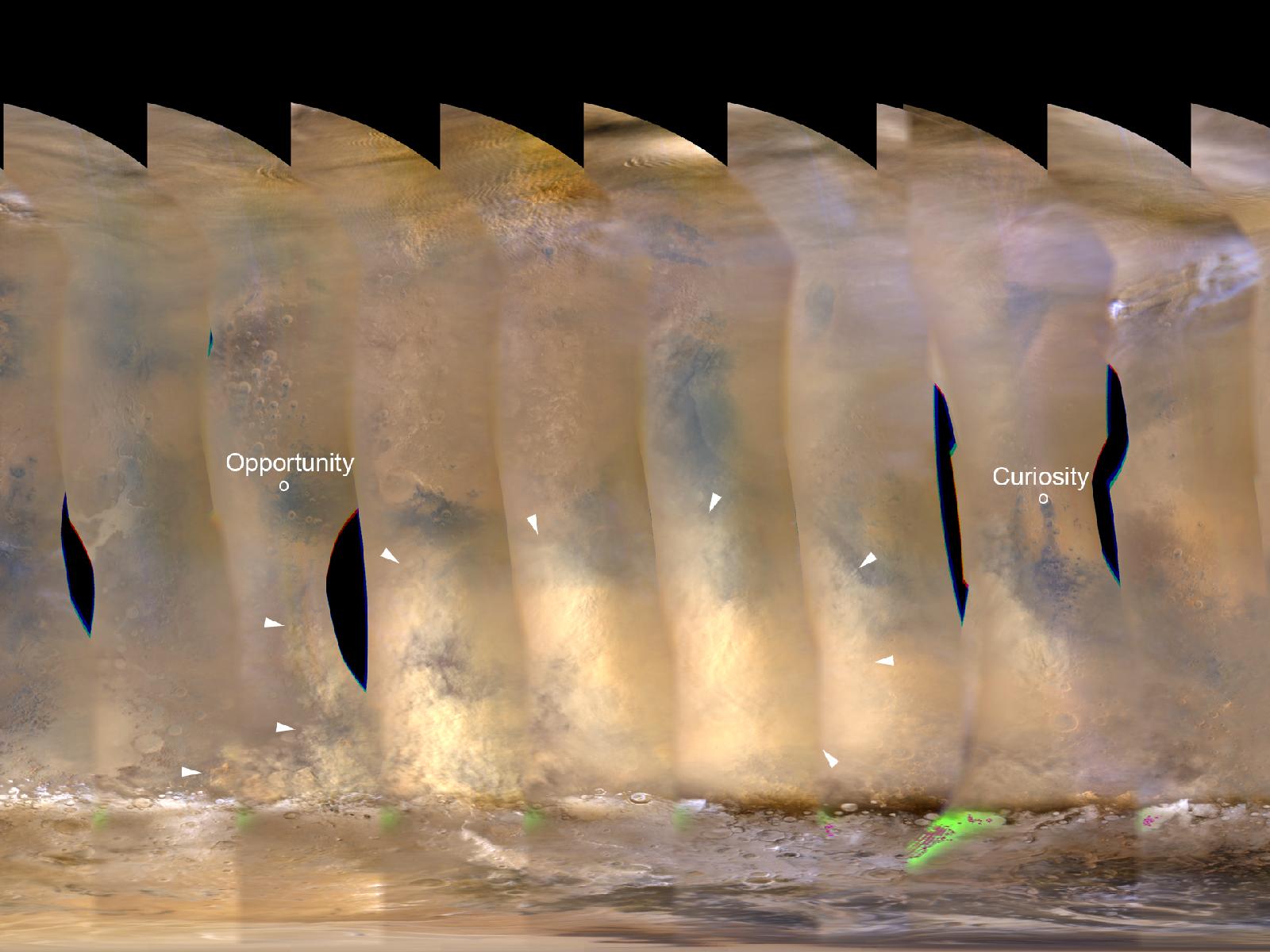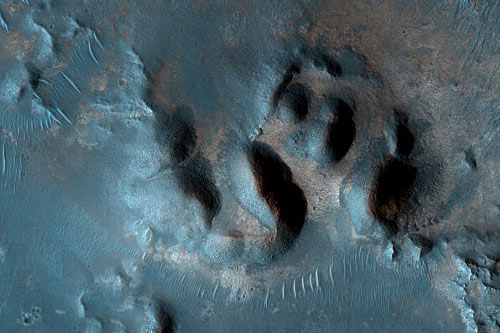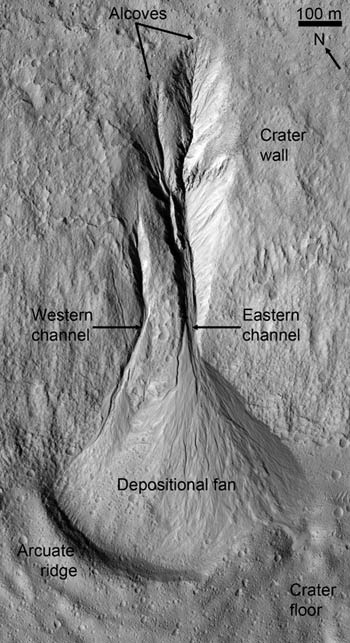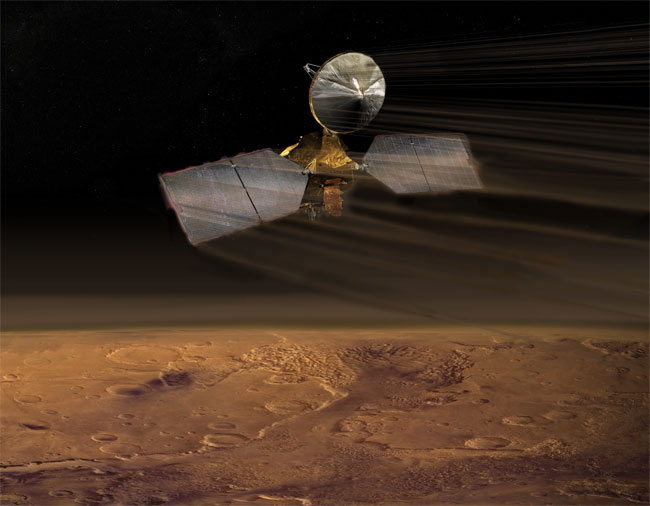Latest Photos from NASA's Mars Reconnaissance Orbiter
New Impact Craters on Mars
Images taken by the UA-led High Resolution Imaging Experiment, or HiRISE, reveal new impact craters that formed between 2010 and 2011. [Read the Full Story]
Soviet Mars 3 Lander
This set of images shows what might be hardware from the Soviet Union's 1971 Mars 3 lander, seen in a pair of images from the High Resolution Imaging Science Experiment (HiRISE) camera on NASA's Mars Reconnaissance Orbiter. Image released April 11, 2013. [Full Story]
Dry Ice Carves Grooves in Martian Dunes
NASA's Mars Reconnaissance Orbiter snapped this series of pictures of sand dunes in the north polar region of Mars, showing how dark sand rises to the top as spring progresses (from left to right) and a surface layer of carbon dioxide ice cracks . The area covered in each panel is about 0.8 mile wide.
Dust Storm on Mars: November 2012
This nearly global mosaic of observations made by the Mars Color Imager on NASA's Mars Reconnaissance Orbiter on Nov. 18, 2012, shows a dust storm in Mars' southern hemisphere. Small white arrows outline the area where dust from the storm is apparent in the atmosphere. [Full Story]
Locations of NASA's Mars rovers Opportunity and Curiosity are labeled. Black areas in the mosaic are the result of data drops or high angle roll maneuvers by the orbiter that limit the camera's view of the planet. Equally-spaced blurry areas that run from south-to-north (bottom-to-top) result from the high off-nadir viewing geometry, a product of the spacecraft's low-orbit.
New Images Used to Pick Mars Lander Site
The Nili Fossae region of Mars is one of the largest exposures of clay minerals discovered. In this HiRISE false-color image, dark blue regions are volcanic minerals. Light-toned areas are clay-rich material and may contain water and organic materials--a possible place where life can be supported.
Gullies Mark Most Recent Water Flow on Mars
The gully system in the Promethei Terra region of Mars appears to have been carved by melt water and may be the most recent period when water was active on the planet.
First Images from Mars Orbiter's High Resolution Camera Wow Researchers
This is the first color image of Mars from the High Resolution Imaging Science Experiment (HiRISE) on NASA’s Mars Reconnaissance Orbiter. This is not natural color as seen by human eyes, but infrared color, shifted to longer wavelengths. The image has been processed to enhance subtle color variations. Seen in the image is what appears to be early-morning fog in the atmosphere. Large-scale streaks are due to the action of wind on surface materials. The blankets of material ejected from the many small fresh craters are generally brighter and redder than the surrounding surface, but a few are darker and less red. Image
Breaking space news, the latest updates on rocket launches, skywatching events and more!
'Another New Mars': NASA Orbiter Ready for Red Planet Science
This enhanced-color view shows gullies in an unnamed crater in the Terra Sirenum region of Mars. It is a sub-image from a larger view imaged by the High Resolution Imaging Science Experiment (HiRISE) camera on NASA's Mars Reconnaissance Orbiter on Oct. 3, 2006. This scene is about 254 meters (about 830 feet) wide.
MRO: Delicate Dips into the Martian Atmosphere
Putting on the brakes! Mars Reconnaissance Orbiter is now dipping into the martian atmosphere to adjust its orbit. The controlled use of atmospheric friction is a process called “aerobraking”, a technique that changes the initial, very elongated orbit of the orbiter into a rounder shape optimal for science operations at Mars. Image
New Mars Craft Sends Back First Detailed Images
The first image from HiRISE reveals a small portion of the floor of Ius Chasma, one branch of the giant Valles Marineris system of canyons on Mars. The MRO spacecraft was about 174 miles (280 km) above the Martian surface when this picture was taken.

Space.com is the premier source of space exploration, innovation and astronomy news, chronicling (and celebrating) humanity's ongoing expansion across the final frontier. Originally founded in 1999, Space.com is, and always has been, the passion of writers and editors who are space fans and also trained journalists. Our current news team consists of Editor-in-Chief Tariq Malik; Editor Hanneke Weitering, Senior Space Writer Mike Wall; Senior Writer Meghan Bartels; Senior Writer Chelsea Gohd, Senior Writer Tereza Pultarova and Staff Writer Alexander Cox, focusing on e-commerce. Senior Producer Steve Spaleta oversees our space videos, with Diana Whitcroft as our Social Media Editor.
